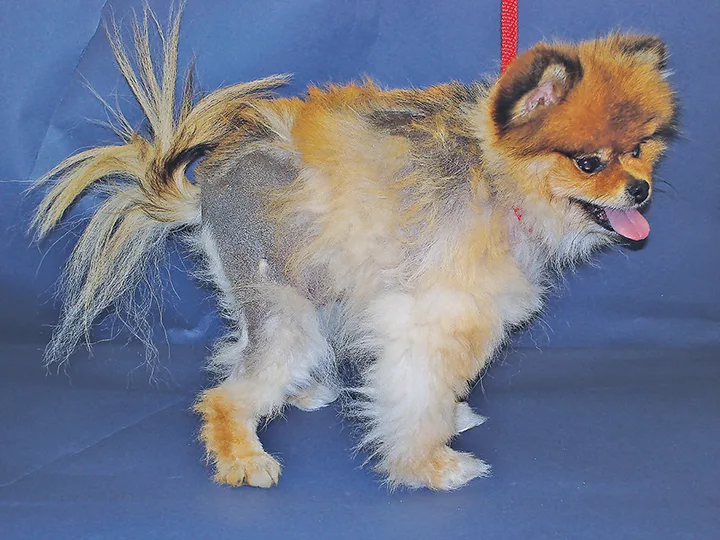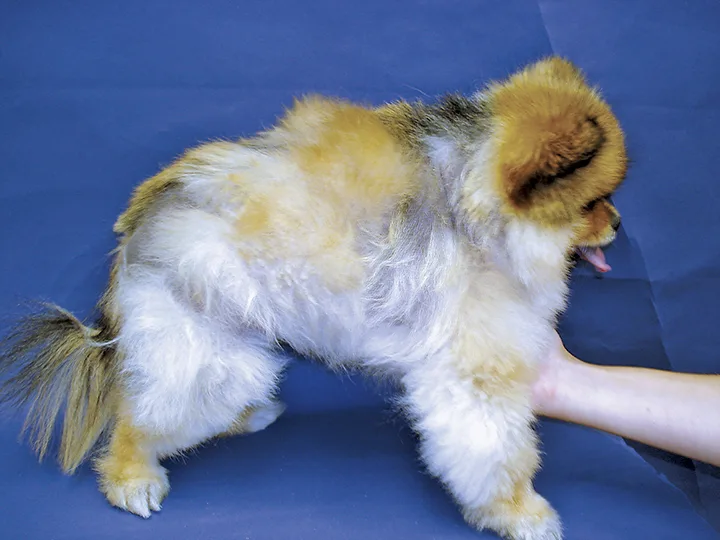Alopecia X in a Pomeranian
Linda A. Frank, MS, DVM, DACVD, University of Tennessee

Ava, a 3.5-year-old, 9.1-lb (4.1-kg) spayed red Pomeranian, was presented to a dermatology service for a 19-month history of progressive, nonpruritic, diffuse alopecia affecting the trunk and caudal thighs. Alopecia was first noticed after surgical correction of right patellar luxation.
Hair on the right pelvic limb that had been clipped for surgery failed to regrow. Alopecia progressed to the trunk, neck, abdomen, and caudal thighs. Ava’s skin in the affected areas became hyperpigmented. Results of a previous low-dose dexamethasone suppression test and thyroid panel were within normal limits; reproductive hormone testing was not performed, and because of Ava’s plush coat before onset of alopecia, investigation into the owner’s use of topical hormone creams was not pursued. Empiric treatment with thyroxine and melatonin (of unknown dose and duration) did not result in hair regrowth, nor did treatment with trilostane (2.4 mg/kg PO q24h for 30 days). Ava was up to date on monthly oral heartworm and flea preventives, was fed a commercial adult canned diet supplemented with treats, and had no other health issues.
Physical Examination & Diagnostics
On physical examination, large areas of hypotrichosis with loss of guard hairs and complete alopecia were noted on the neck, chest, abdomen, caudal thighs, and flanks (Figure 1). The skin in the affected areas was hyperpigmented with a mild, dry, adherent scale. The distal extremities, tail, and face were unaffected. In addition to generalized scaling, multiple epidermal collarettes were present on the dorsum, neck, and caudal abdomen.

Ava’s skin showing alopecia, hypotrichosis, and hyperpigmentation
Initial diagnostics included skin scrapings and skin cytology to screen for infectious agents. CBC, serum chemistry profile, and urinalysis were also performed to screen for underlying disease processes. CBC and serum chemistry profile were unremarkable with the exception of a mild increase in glucose, which was attributed to stress. Urinalysis was within normal limits. Skin scrapings were negative for mites. Skin cytology revealing many neutrophils with intracellular cocci was compatible with superficial pyoderma.
Diagnosis
Based on breed, age at alopecia onset, and the lack of other clinical signs or laboratory abnormalities, diagnoses of alopecia X and secondary pyoderma were made. Although a biopsy can help confirm noninflammatory alopecia, histopathology cannot differentiate alopecia X from other noninflammatory diseases; therefore, biopsy was not performed in this patient.
Alopecia X is a noninflammatory form of alopecia that affects canine breeds with thick undercoats (eg, Pomeranian, Alaskan malamute, chow chow, keeshond).1 The disease is recognized in both intact and neutered dogs and affects males and females equally, with onset between 1 and 10 years of age. Affected dogs develop bilaterally symmetrical alopecia that spares the head and distal extremities and is usually accompanied by hyperpigmentation of the skin.1 Alopecia X is a diagnosis of exclusion, as the pathophysiologic mechanism is unknown (see Take-Home Messages).
Treatment & Outcome
Pyoderma was treated with cefpodoxime (12 mg/kg PO q24h), which was administered slightly above the label dose (5-10 mg/kg q24h) to accommodate pill size, for 30 days. The patient was also bathed twice weekly with a 3% chlorhexidine-based shampoo. Cefpodoxime was chosen for its q24h dosing to accommodate the dog’s small size and the owner’s difficulty in administering oral medications. Cefpodoxime has been shown to be effective in the treatment of staphylococcal infections.2 Although some dermatologists will use cefpodoxime as a first-line agent,3 others recommend third-generation cephalosporins be used as first-line agents only if there is a problem with owner compliance, as in this case.4
Alopecia X treatment options presented to the owner included retrying melatonin (3 mg PO q12h for a minimum of 3 months) or monthly medroxyprogesterone acetate injections (5 mg/kg SC), although, at the time of recommendation, success rates were unknown and treatment was novel. Medroxyprogesterone acetate injections were considered because synthetic progestins can induce endogenous growth hormone secretion, and growth hormone has historically been used to treat alopecia X.5 Possible adverse effects include development of mammary nodules and cystic endometrial hyperplasia; however, these effects are not of concern in dogs that have undergone ovariohysterectomy. Diabetes mellitus is a possible sequela but has been reported only in a small number of dogs in one study.6
Because of melatonin’s previous lack of efficacy in this patient and the owner’s difficulty administering medications, the owner elected therapy with medroxyprogesterone acetate injections. The patient’s monitoring plan also entailed monthly serum chemistry profiles and urinalyses to monitor for adverse effects (see Treatment at a Glance).
Treatment At A Glance
Intact dogs with alopecia X should be spayed or neutered, as hair regrowth may occur after surgery.9
Treatment with deslorelin has been successful in some intact male dogs.10 Follicular cysts and prolonged estrus have been described in a female dog.11
Melatonin (3-9 mg [≈1 mg/kg for small dogs] q12h) has resulted in hair regrowth in 40% to 60% of dogs with alopecia X.12 Exceeding a total dose of 9 mg often results in profound sedation and therefore is usually not prescribed. Treatment should be continued for a minimum of 3 months, but treatment for 6 to 9 months may increase positive results.12 Adverse effects include sedation and, possibly, insulin resistance.12
Monthly medroxyprogesterone acetate injections (5-10 mg/kg SC for 4-6 months) may result in hair regrowth in a portion of dogs with alopecia X.5
Trilostane and Lysodren have been reported to result in partial-to-complete hair regrowth in more than 90% and 67%, respectively, of dogs with alopecia X.12,13 Close monitoring is advised.
A microneedling procedure, as used in human cosmetic dermatology, reportedly resulted in hair regrowth in 2 female Pomeranian siblings.14 The procedure was performed with the patients under general anesthesia using a human microneedling device.
As reported and in the author’s experience, the new hair is rarely permanent and will often fall out in months to years15; therefore, discontinuation of any treatment once hair regrowth has occurred is recommended. When hair loss resumes, reinstitution of the previous treatment or beginning another treatment should be considered.
No hair regrowth was noted during the first 3 monthly rechecks. By the fourth recheck, after 4 monthly injections, there was evidence of incomplete hair regrowth (Figure 2). The skin was no longer scaly, and the degree of hyperpigmentation had decreased. No abnormalities were detected on blood work throughout the treatment, and no adverse effects were reported. Because the patient had begun to show signs of improvement, an additional 2 monthly injections (total of 6) were administered, after which hair regrowth improved minimally.

Ava after 4 monthly injections of medroxyprogesterone acetate (5 mg/kg SC). Decreased areas of alopecia, scaling, and hyperpigmentation of the skin can be noted.
Prognosis
The prognosis for alopecia X is guarded for complete hair regrowth, and any new growth following treatment may not be permanent.1 Hair might remain for a period of months to years, at which point alopecia may recur1; in these cases, medroxyprogesterone acetate injections or another therapy could be attempted.
Take-Home Messages
Alopecia X affects plush-coated breeds and is recognized in Pomeranians and other breeds.1
Alopecia X is a diagnosis of exclusion, as the pathophysiologic mechanism is unknown; other causes of hair cycle arrest (eg, hypothyroidism, hyperadrenocorticism, reproductive hormone disorders of intact animals) should be ruled out.7
Biopsy and histopathology should be performed to rule out inflammatory causes of alopecia (eg, sebaceous adenitis). Histopathology will not differentiate alopecia X from endocrine causes of alopecia.8
Alopecia X can be associated with secondary skin changes and pyoderma.
No treatment is guaranteed to be successful. Potential adverse effects of treatment must be weighed with the clinical presentation of a cosmetic condition.